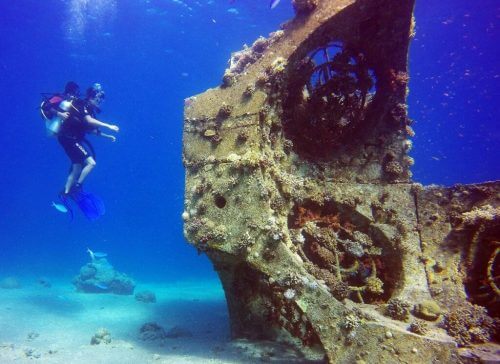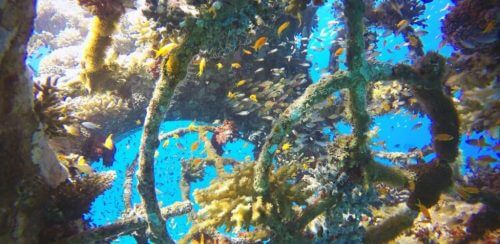Artificial diving sites in Eilat attract divers at the beginning of their journey and reduce the damage caused to the natural coral reefs. Will additional artificial diving sites help restore the coral reef in Eilat, or will they just pollute the sea with more junk?

By Maya Falah, Angle, Science and Environment News Agency
Israel is a unique country in terms of its natural treasures: within its narrow borders you can find, among other things, the northernmost coral reef in the world - in Eilat. The preservation of this reef is particularly important, because that the world's coral reefs are suffering from bleaching As a result of the warming of the oceans, while the corals in the Eilat Bay precisely In the meantime, they are discovering a surprising resistance against the effects of climate change.
But it is also no secret that the reef in the Gulf of Eilat has suffered in recent decades from a continuous deterioration in its condition. Massive oil pollution in the XNUMXs, phosphates and sewage discharged into the bay in the XNUMXs and XNUMXs and the introduction of fish cages into its waters in the mid-XNUMXs severely damaged the condition of the reef.
The rush of divers that visit the reef, especially in the summer months, is a considerable threat to its existence. A load of inexperienced divers may jeopardize its future due to contact with the corals and their breakage, and also due to floating sand from the bottom that may cover the corals.
Is it possible to find a solution that can reduce this threat? Article of Israeli researchers recently published in the journal "Journal of Environmental Management" shows that artificial reefs - that is, reefs built artificially on top of objects that drowned or were drowned in the sea on purpose - reduce the damage caused by divers to the natural coral reefs in Eilat.
Reefs attract fire
The new study, which was conducted by Dr. Yaniv Belhassan from the Department of Hotel and Tourism Management at the Eilat campus of Ben-Gurion University of the Negev and student Megan Russo from South Africa, examined the extent of diving in Eilat at various sites and the behavior of the divers there. The research shows that more than a third of the dives in Eilat are currently carried out at artificial sites, chief among them the Steel site - the Ahi Sofa missile ship that was sunk in the XNUMXs to serve as a diving site.
In addition, the researchers focused on Tamar Reef - an artificial reef that was sunk in 2007 in collaboration with the Nature and Parks Authority, and which was built from the beginning with trainee divers in mind - and compared it to two nearby sites where there is a natural reef. The researchers counted, for example, how many times the divers touched the reef with their fins and diving equipment, how many times they caused sand to float up from the bottom (which harms corals because it blocks their "breathing" openings), how many times they caused corals to break, and more.
"The study showed that the damage to the Tamar reef is more serious than what happens to the natural reefs, because the artificial reef 'attracts fire' - that is, the beginner divers, who tend to do more damage unintentionally, says Prof. Nadav Shasher, the academic director of Ben-Gurion University in Eilat .
Keep man away from nature?
Opponents of burying an artificial bone in the sea claim that such a step could harm nature more than preserve it. To this Shasher replies that "there is an attitude that says that humans and nature do not go together - and therefore we need to keep them away and create closed nature reserves. According to such an approach, diving in the reef area should only be allowed accompanied by a guide - and thus nature will not be harmed. The second approach, on the other hand, suggests finding a way to combine humans and nature - to foster tourism, to encourage visits to nature and human activity in it, in a way that nature will not be harmed. This approach is the basis behind the establishment of artificial reefs. The stated goal of Tamar Reef was to attract new divers and trainees, in order to reduce their impact on the natural reef - and the findings of the study strengthen the evidence that this is indeed happening."
"The reef in Eilat suffers from very high diving pressure in relation to its size - about 350 dives per year," adds Shasher. "This is an amount of clarity that exceeds what the reef can bear. In the 70s the coral cover in the reef in Eilat was about 70 percent, today it remains only about 30 percent. Indeed, in recent years the monitoring program of the Bay of Eilat shows that there is little recovery, but unfortunately it is not something dramatic.'
Shasher now regrets that the creation of more artificial reefs is not currently in sight. "It depends on the Nature and Gardens Authority," he says. "Today the business has stopped, the authority decided that it does not want to make new artificial reefs - and as a result nothing is happening at the moment. It's a shame, because we've already done it in many places in the world. In the meantime, until they decide to implement it here, I'm going next week to set up artificial reefs in Australia.'
Junk on the beaches of Eilat
Indeed, the Nature Authority and the Gardens are not particularly enthusiastic about the idea. "I have no objection in principle to artificial reefs, but it needs to be done very wisely and carefully - which I don't think has been done so far," says Assaf Zebuloni, an ecologist of the Gulf of Eilat on behalf of the Nature and Parks Authority. "What is put into the sea never comes out of it, even if in the end it does not fulfill the purposes for which it was put, or even constitutes an ecological hazard."
"Despite the newly published article, I don't see artificial reefs as the right way to protect the natural coral reefs," says Zebuloni. "I would not suggest drawing conclusions based only on the Tamar reef, but on the basis of many artificial objects that have been put into the sea - and indeed there are many of these along the 12 kilometers of Eilat's beaches, such as amphibious vehicles, a huge electricity pole and more. Some attract a lot of divers and some not at all. In fact, it is difficult to dive along the coast of Eilat without seeing artificial objects and, unfortunately, too few natural areas remain."

"One of the overarching goals of the Nature and Parks Authority is preserving nature and making it accessible to the public," adds Zebuloni. "When foreign objects are introduced into the sea, it is not a matter of preserving nature, but of violating it." As an example of a negative action at sea, Zebuloni mentions the sinking of a vessel in Island Line in the central Pacific Ocean, which destroyed the coral reefs in a huge radius around the ships, due to the change in the availability of iron in the ocean water in the area.
"I think the public should be encouraged to go out into nature, observe it, enjoy it and appreciate it, but they should also be taught to take care of it," says Zebuloni. "Even on artificial reefs, animals eventually grow. If the diving in the reserves will be guided diving only, by diving instructors who, in addition to their professionalism as instructors, will also acquire knowledge and understanding of nature conservation, then everyone will benefit."
See more on the subject on the science website:

4 תגובות
Decide, either he is the creator of the universe or he is only the creator of one world - the earth?
I have been familiar for years with this quote that the Authority presents about a change in iron concentrations, what they do not mention is that an entire reef was built there in Menash from a huge amount of iron scrap. They also forget to mention that right in front of us the Jordanians watered many tanks years ago, when the effects as far as we know are only positive. Conservatism can also be harmful
The northernmost reef is in Japan Tsushima (34 degrees north)
while Qailat is located at 29.55 degrees North)
Over and over and over again
Notable in the discussion is the lack of reference to the carrying capacity of the area,
It turns out that the "authority" forgot their role
Because when the ecologist of the Gulf of Eilat says that:
""One of the overarching goals of the Nature and Parks Authority is
Preserving nature and making it accessible to the public'
He is wrong and misleading since according to the law the authority's role is to preserve nature
and not "its accessibility to the public",
Making it accessible to the public is a necessity that stems from a set of considerations,
Therefore once again the accessibility to the public must be based on the carrying capacity of the reserve, since in a project to protect a reserve carrying capacity is (always) a compromise
There is no choice between the need to preserve and the need to make it accessible to the public
act arbitrarily and limit the number of visitors/divers,
Creating artificial dive sites eases the pressure
But this does not release the authority from the obligation (according to law)
preserve nature
which necessitates limiting the accessibility of visitors/divers,
Because again: the authority's role/duty to preserve nature,
Its "accessibility" is a (obscene) necessity created because
The explosion of the human population!
And I have already written about this over and over again because:
The time has come that instead of controlling the environment for the sake of the human population,
There will be control over the human population for the sake of the environment.